Your Friday a Cappella Group Cover of iPhone Ringtones
They also covered Windows sound effects.
i wanted to make a joke about the boat but it looks like that ship has sailed
— rosemary donahue (@rosadona) March 29, 2021
Graphene Gear
Was it a good week for graphene news? It’s always a good week for graphene news! Since its discovery just a few short years ago, graphene has made its way into a number of products and research projects. One example is Inov-8 running shoes and hiking boots that include Graphene-enhanced foam. The cushioned foam, called “G-Fly,” features as part of inov-8’s Trailfly Ultra G 300 Max shoe—a product aimed at “ultra runners.” Scientific tests reportedly show that the foam infused with graphene can deliver 25% greater energy return. It is also claimed to be far more resistant to compressive wear.
But there is even more graphene news, because it’s just that kind of material. We give you: graphene-enhanced concrete. Says GrapheneExponent (you knew there had to be a whole website dedicated to graphene news):
The graphene present within the product improves the hardening process of the concrete, creating a stronger, thicker concrete. This mixture has the potential to be revolutionary in the production of concrete for buildings, leading to superior, more powerful concrete on the market.
Shoes and concrete…wait until the mob hears about this and does their own mashup.
Choices
Urgh I wanted the Pfizer one pic.twitter.com/bOAaCF3naY
— Sam P (@samjoshphillips) April 3, 2021
Cotton Club
Designed to help address water scarcity and pollution caused by cotton dyeing, Ralph Lauren’s Color on Demand is a multi-phased system with a clear ambition to deliver the world’s first scalable zero wastewater cotton dyeing system, enabling the recycling and reuse of all water from the dyeing process.
Lost and Found
ironically, i WAS doing well, and then your email found me.
— Molly Priddy (@mollypriddy) April 1, 2021
Monkware
Friend of Around the Web JerrytheMacGuy watched Frank Romano’s video a couple of weeks ago about ironic scribe Johannes Trithemius and it brought to mind a Kendra Allenby New Yorker cartoon:
They Call Me MISTER Rogers
March 20 was the birthday of Mister Rogers, who, for those of a certain generation, was a beloved childhood television personality, such that “Mister” isn’t even abbreviated. He was also fond of cardigan sweaters, and in tribute to the late Mister Rogers, Owen Phillips of The F5 newsletter has created a chart that chronologically depicts the color of every cardigan he wore from the start of Mister Roger’s Neighborhood in 1969 until the show’s final episode on August 31, 2001, and this 14x21-inch chart is available for purchase and suitable for framing.
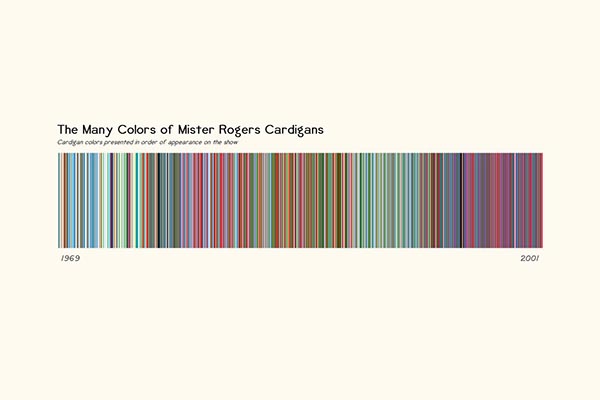
“This fine art paper print features a soft textured surface similar to traditional watercolor and etching paper, for a finished matte look.”
Do the Math
'Eleven plus two' is an anagram of 'twelve plus one'
— Richard Osman (@richardosman) April 1, 2021
You’re Soaking in It
Who among us has not wanted to, instead of discarding packaging, simply be able to take a bath in it? Well, admittedly, probably very few. But one brand’s packaging can actually be recycled into a bath product. Meet German designer Jonna Breitenhuber and SOAPBOTTLE, a new line of personal care products made entirely of usable soap. Via Core77:
Seeking to replace the kind of disposable, single-use plastics that make up the bulk of this type of consumer waste, she began experimenting in her studio with several prototypes before arriving at a line of brightly colored bottles, each containing 100 ml of a soft and soothing body wash made from natural ingredients, now funding on Kickstarter until April 22.
… After testing out prototypes in wax, metal, glass, and ceramics, she wanted to be more daring, inspired by the food industry where products themselves often become packaging—imagine an ice cream cone or an edible bread bowl. Similarly, with SOAPBOTTLE, once the liquid contents are finished, the empty container can be used as regular hand soap that safely goes down the drain, often decomposing in the sewage plant within days.
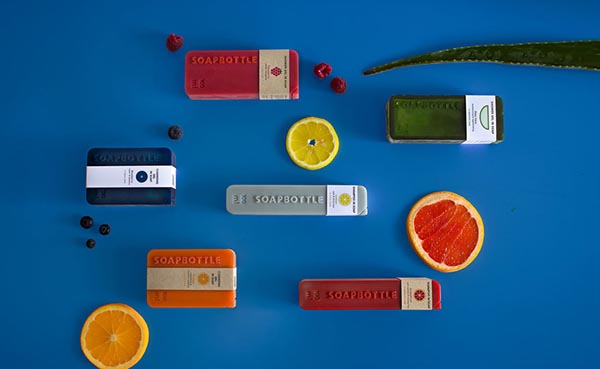
The New Normal
really bummed that soon i will have to stop cancelling plans "due to covid" and start canceling plans with my usual bag of petty lies
— Gus Danger Johnson (@Gusbuckets) March 30, 2021
All the News that Fits on the Wall
Last year, we linked to a story about a Google engineer who created a giant E Ink screen to display the front page of the New York Times. Greg Raiz went further and created a wall-mounted 32-inch E Ink newspaper that cycles through multiple newspapers, updates every day, and uses very little power.
The display is based on the Visionect 32″ place and play display. This works by running two components. The eInk display acts as a thin client and has very little processing power. The eInk requires no power and the rest of the hardware just listens on an open port drawing very little power.
The display is 99% more power efficient than a traditional LCD, so the display can run for months without being charged. Because the display is a thin client it requires two external components to make it work. The first is an HTML rendering server. This fetches web-pages and renders them as a headless browser. It can then push images to the display. The second is an application server that fetches newspapers from around the country, downloads the PDF’s and turns those into images and HTML that can be processed.
Wedding Album
The couple on the Woodstock album cover, still together 52 years later. pic.twitter.com/CNXgUvud6t
— Eric Alper ??(@ThatEricAlper) April 2, 2021
Good Days and Mad
Folks who grew up in the 1960s and 70s fondly remember Mad Magazine, with Al Jaffee, Don Martin, Mort Drucker, Dick DeBartolo, Sergio Aragonés, and more—the “Usual Gang of Idiots,” per the masthead—becoming household names. Mental Floss’s Throwback video series this week looked at the origins of Mad magazine, which started off as a parody of other comic books before evolving into the all-encompassing humor magazine it became.
Say What?
I really don’t get things. https://t.co/fZsENjDJko
— Kevin Murphy (@kwmurphy) April 1, 2021
Boson Buddies
The results of a Fermilab experiment this week raised all serious questions about our basic understanding of the universe. But we’ll skip that because obviously linking to a story about a ketchup shortage is far more urgent.
Just kidding. Actually, it was an experiment that involved running muons—subatomic particles like electrons but heavier, and integral to the composition of the cosmos—through magnetic fields and the muons didn’t behave the way they were expected to. Says the New York Times: “The result, physicists say, suggests that there are forms of matter and energy vital to the nature and evolution of the cosmos that are not yet known to science.”
The aberrant behavior poses a firm challenge to the Standard Model, the suite of equations that enumerates the fundamental particles in the universe (17, at last count) and how they interact.
“This is strong evidence that the muon is sensitive to something that is not in our best theory,” said Renee Fatemi, a physicist at the University of Kentucky.
…Most physicists believe that a rich trove of new physics waits to be found, if only they could see deeper and further. The additional data from the Fermilab experiment could provide a major boost to scientists eager to build the next generation of expensive particle accelerators.
It might also lead in time to explanations for the kinds of cosmic mysteries that have long preoccupied our lonely species. What exactly is dark matter, the unseen stuff that astronomers say makes up one-quarter of the universe by mass? Indeed, why is there matter in the universe at all?
Now, it’s good to get excited, but there is far more data that needs to be gleaned.
The measurements have about one chance in 40,000 of being a fluke, the scientists reported, well short of the gold standard needed to claim an official discovery by physics standards. Promising signals disappear all the time in science, but more data are on the way. Wednesday’s results represent only 6 percent of the total data the muon experiment is expected to garner in the coming years.
Still, for those hipsters who think that the current laws of physics are just so yesterday, this is promising news indeed.
give a pulitzer to whoever it was that was able to get all this into a tweet https://t.co/GnBGhteXVs
— Sam Stein (@samstein) April 7, 2021
Great Moments in Signage
Getting some real mixed messages from this sign pic.twitter.com/PHTsAtuzo0
— Elliott Kalan (@ElliottKalan) April 7, 2021
Home Depot
Who among us has not wanted to bring the railroad station or airport terminal experience into our own home? (Well, actually, over the past year, that was sorely tempting.) As it turns out, the folks at Vestaboard can help you out with one aspect of that experience: the animated flipboard sign, which themselves have long been absent from most modern ports of call. Now you can bring a little Grand Central Station into your own home, office, or home office. Via Gizmodo:
The Vestaboard Smart Messaging Display could have easily been created using a high-res LCD display running photo-realistic animations or real-time 3D renders of the flipboard effect. But the display instead does things the old-school way with 132 spinning mechanisms that can each display 64 different characters, including solid colors.
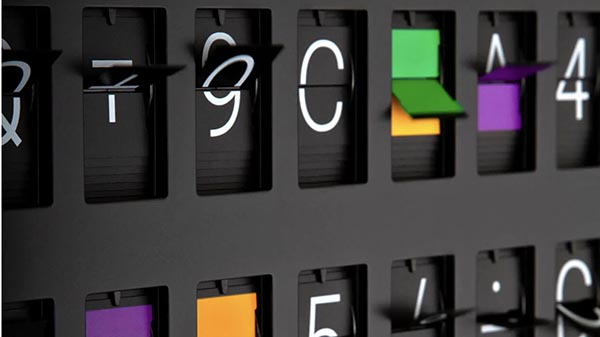
They continue:
Unlike the pixels that make up a flatscreen that can instantly change color to produce new imagery, each mechanism on this board has to spin until the flaps bearing the requested character are displayed, resulting in both a satisfying visual effect and a unique sound as the Vestaboard is refreshed.
And it would be perfect—as the originals were—for scheduling:
Programming the Vestaboard seems easy enough using either a web-based interface or a smartphone app that delivers commands over wifi to the display. Users can simply design a custom message by hand, or the Vestaboard can be programmed to automatically pull data like weather forecasts or upcoming calendar appointments. There are scheduling capabilities too, as well as the ability to give others remote access to the signage so you could, for example, update your family on your ETA on the way home, bringing the display back full circle as a legitimate Arrivals board.
Think of it: be reminded of the next WhatTheyThink LunchNearn Webinar by means of a giant flipboard sign!
The Little Engine that Could
‘Aspirational’ Amtrak Map Depicts Train Car Married, Happy, With Little Caboose Baby https://t.co/dqNEQzUGSZ pic.twitter.com/5LZwCyQsSg
— The Onion (@TheOnion) April 5, 2021
Current Affairs
When it comes to fueling our vehicles, we’re all pretty spoiled by how easy it is. You can pull into any gas station anywhere in the country and fuel up with minimal difficulty. Imagine what a headache it would be if every make of automobile needed its own proprietary fuel pump design in order to gas up. Well, that’s apparently the situation with electric vehicle charging. Says Vice:
There are currently two charging networks: Tesla's and everyone else's. Tesla's charging experience is great, one of the major perks of owning their vehicles. Just plug your Tesla into a Supercharger and it starts charging. They are fast and reliable. You're on your way in no time.
Everyone else's network is, quite frankly, bad, in almost every sense of the user experience. Just a few years ago, anyone doing a road trip in a non-Tesla EV would need "to carry a wallet full of RFID cards" that allow them to charge their car at various charging stations owned by different companies, recalls Chris Nelder of the Rocky Mountain Institute who has studied EV charging infrastructure for years. Such a road-tripper would also have needed to be a member of a handful of different charging networks, and have signed up for them before beginning the trip because you couldn't sign up on the spot.
…Major automakers say they're getting serious about competing with Tesla. The smart ones realize that means more than just making competitive vehicles. It also means offering a competitive charging experience, something they can't do with the current patchwork of third-party chargers over which there are few standards and little control over the actual customer experience. Something needs to change.
Of course, this situation is not without precedent. In fact, in the early days of the automobile, different car models ran on different kinds of fuel. “Only once cars became popular did the industry start to set standards for what gasoline actually was. The federal government's Bureau of Mines contributed to this effort by setting standards for any fuel it procured, nudging the industry towards standardization.”
It’s possible (but maybe not probable) that this situation will rectify itself once electric vehicle ownership reaches a certain critical mass. But for early adopters or those who are really eager to dive into electric vehicles, this does present a major logistical problem.
Car Talk
modern cars are a nightmare https://t.co/lzkJASumB9
— Internet of Shit (@internetofshit) March 25, 2021
Are Friends Electric?
Speaking of electric cars, Time had an interesting story on the noise that electric vehicles make. Which is to say, none at all.
Because their motors have few moving parts, electric vehicles (EVs) are shockingly quiet. That might sound like a blessing for city dwellers and others sick of traffic noise, but it can create added risk for drivers (who rely on engine noise to get a sense of their speed) and pedestrians (who listen for oncoming traffic). For automakers, it also compromises decades of marketing based on the alluring rumble of a revving engine, especially in sports cars and trucks.
As a result, EV manufacturers are starting to think about what kinds of sounds they can have their cars make.
So companies like Ford have turned to elite teams of sound designers to create new noises that play from EVs’ internal and external speakers, making them safer and more marketable. With EVs on the cusp of widespread adoption—analysts predict their share of U.S. auto sales will quadruple to 8.5% in the next four years—these specialists are getting a once-in-a-lifetime chance to create the sounds that will dominate 21st century highways and cities, just as the constant drone of internal-combustion engines dominated those of the 20th.
After all, they have to make some noise:
Regulators around the world require EVs to emit some kind of sound for safety reasons, though they’ve left it up to automakers to decide exactly what that sound should be—a big challenge, given that they could theoretically sound like just about anything. “It’s kind of like when [the 1993 film] Jurassic Park was made, and they had to come up with the sound of a dinosaur,” says Jonathan Pierce, a senior manager of experiential R&D at Harman, an automotive-technology company. “None of us has ever heard a dinosaur.”
…The LEAF sound, Venne says, has “a little bit of a singing quality to it.” GM also took a step in the musical direction, creating EV sounds using sampled guitar, piano and didgeridoo. “We want it to sound organic, yet futuristic,” says GM sound engineer Jigar Kapadia.
Well, we think the answer is obvious:
Today’s Dystopia
just got this frightening press email
— Sean Aitchison (@Sean8UrSon) April 5, 2021
IT COUNTS PEOPLE IN THE ROOM SO IT CAN CHARGE PER PERSON??!?!
capitalism is fucking exhausting pic.twitter.com/9hDEhor6UT
Driven to Distractions
If you’re like a lot of people, over the past year, you likely took up some number of new hobbies and other distractions to keep you occupied during lockdown and quarantine, and many of those may persist and remain popular after the COVID crisis is over. After all, this sort of phenomenon is not unprecedented. CNN had an interesting look back at a previous era in which people had loads of unscheduled free time: the Great Depression. It was actually during the Depression—when millions of Americans were out of work—that a lot of what became popular pastimes were first taken up in earnest, hobbies such as stamp collecting, music making, woodworking, and birdwatching. It’s also when the card game bridge became popular.
Similar to the Great Depression, troves of Americans were left jobless after the pandemic shut down the US economy. Last spring, the US shed more than 22 million jobs. Many of these people have been able to go back to work as the economy gradually reopened, but the nation still remains down 9.5 million jobs compared to February last year.
Amid such disruptions to daily life, hobbies -- old and new -- served as a bright spot.
"It doesn't take a lot to keep yourself occupied with a newfound hobby, and that's what people discovered during the Depression as well," Mihm said. "They could do many different things to keep themselves occupied that really cost very little money."
There are some differences, though.
Thanks to the internet, new hobbies are easy to find and even easier to partake in. But the surplus might have made them more fleeting.
Birdwatching and playing games, popularized in the late 1920s and early 1930s, for example, remain common hobbies to this day.
But tie-dyeing clothes, attending PowerPoint parties and partaking in TikTok challenges -- among the many hobbies that popped up in the last year -- may not be things that people do in the years to come.
In the 1920s and '30s, people weren't limited socially as they have been in the last year.
So, during the Great Depression, people were "more likely to kind of get into a hobby where you were likely to encounter people nearby who also did it," Mihm said.
During the pandemic, however, people have had to cope with social isolation, especially early on during stay-at-home orders. The excess amount of time at home led to a slew of indoor activities, especially virtual ones.
Bowlful of Apocalypse
Everyone should know this, purely for safety reasons. @EricIdle https://t.co/efiVi6HQRj
— Miss E Houston ????????(@TheReadWarrior) April 5, 2021
Celebrity Hangout
Over the past year, we have occasionally linked to stories depicting how restaurants are handling the encouragement (or enforcement) of social distancing, whether it be giant sombreros and noodle hats, or what have you. Earlier this year, when NYC restaurants were allowed to open to 35% indoor occupancy, via Laughing Squid, Brooklyn steakhouse Peter Luger partnered with Madame Tussaud’s to fill empty seats or spaces at the bar with wax replicas of celebrities. Said Peter Luger Vice President Daniel Turtel: “We’re excited to welcome diners back indoors at 35%, and thought this would be a fun, safe way to fill some of the seats that need to remain empty as we continue to fight the pandemic. It has been wonderful working with the fabulous team at Madame Tussauds New York.”
“Al Roker” greeted diners, tables were occupied by “Audrey Hepburn” and “Jimmy Fallon,” Jon Hamm as Mad Men’s Don Draper stood—where else?—at the bar.
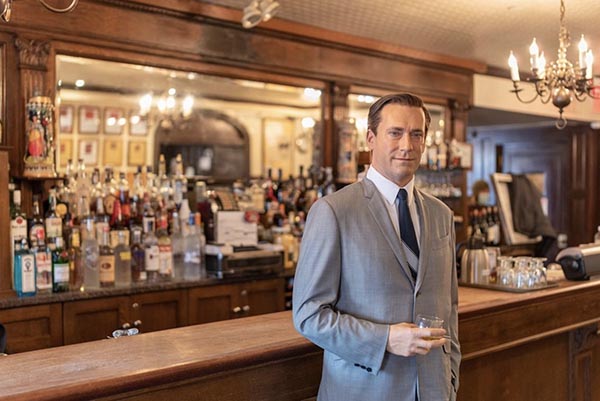
Image via Madame Tussauds New York.
The Teddy Bear’s Picnic Lunch
I want this even when there is no pandemic. https://t.co/zLGlSQcsYv
— Bina Venkataraman (@binajv) April 2, 2021
Fowl Behavior
Here’s a perennial question that until now has only ever been theoretical: can you cook a chicken by slapping it? Actually, it turns out you can, should one want to, as this instructional video demonstrates. We hasten to add that the chicken in question was a store-bought roaster; this is not a chicken snuff film. (We prefer potatoes instead of snuffing.) We also note that the video was sponsored by Hello Fresh, which is what you might say to a chicken as you were about to slap it.
To get it to a safe eating temperature, it does take 135,000 slaps, which is about as many as it’s tempting to administer to the next person who raves about an air fryer.
Fried
My friend told me I should purchase an "air fryer." I said "I don't care how you cook it. I am not interested in eating air." pic.twitter.com/hvzyTpY8OJ
— ben "goodzilla" flores (@limitlessjest) April 5, 2021
Condiment Crisis
Oh, about that ketchup shortage we hinted at earlier… Says the Wall Street Journal:
After enduring a year of closures, employee safety fears and start-stop openings, many American restaurants are now facing a nationwide ketchup shortage. Restaurants are trying to secure the tabletop staple after Covid-19 upended the condiment world order. Managers are using generic versions, pouring out bulk ketchup into individual cups and hitting the aisles of Costco for substitutes.
…The pandemic turned many sit-down restaurants into takeout specialists, making individual ketchup packets the primary condiment currency for both national chains and mom-and-pop restaurants. Packet prices are up 13% since January 2020, and their market share has exploded at the expense of tabletop bottles, according to restaurant-business platform Plate IQ.
We may soon even hear that Heinz is down to 41 varieties.
The Cycle of Life
The three ages of a band, via cabbie conversations
— Mat Osman (@matosman) April 1, 2021
1 - “Suede? Oh yeah, my daughter likes you”
2 - “Saw you guys at the Kilburn National back in the day”
3 - “Suede? Oh yeah, my dad likes you”
This Week in Printing, Publishing, and Media History
March 29
1871: Royal Albert Hall is opened by Queen Victoria.
1886: John Pemberton brews the first batch of Coca-Cola in a backyard in Atlanta.
1943: English actor and comedian Eric Idle born, looking on the bright side of life.
That’s great. Oddly I had calculated this for a title I like. https://t.co/t8i4uZmGg4
— Eric Idle (@EricIdle) April 7, 2021
1999: The Dow Jones Industrial Average closes above the 10,000 mark (10,006.78) for the first time, during the height of the dot-com bubble.
March 30
1853: Dutch-French painter and illustrator Vincent van Gogh born.
1880: Irish dramatist, playwright, and memoirist Seán O'Casey born.
1986: American poet and etymologist John Ciardi dies (b. 1916).
2004: English-American journalist and author Alistair Cooke dies (b. 1908).
March 31
1596: French mathematician and philosopher René Descartes born.
1631: English lawyer and poet John Donne dies (b. 1572).
1685: German organist and composer Johann Sebastian Bach born.
1732: Austrian pianist and composer Joseph Haydn born.
1809: Ukrainian-Russian short story writer, novelist, and playwright Nikolai Gogol born.
1855: English novelist and poet Charlotte Brontë dies (b. 1816).
1889: The Eiffel Tower is officially opened. (Not everyone in France was a fan; author Guy de Maupassant ate lunch every day at the tower’s base restaurant, because, he said, “inside the restaurant was one of the few places where I could sit and not actually see the Tower!”)
1906: The Intercollegiate Athletic Association of the United States (later the National Collegiate Athletic Association) is established to set rules for college sports in the United States.
1918: Daylight saving time goes into effect in the United States for the first time and, unfortunately, not the last.
1930: The Motion Picture Production Code is instituted, imposing strict guidelines on the treatment of sex, crime, religion and violence in film, in the U.S., for the next 38 years.
1951: Remington Rand delivers the first UNIVAC I computer to the United States Census Bureau.
2016: Scottish comedian, actor and screenwriter Ronnie Corbett dies (b. 1930).
April 1
1854: Charles Dickens’ novel Hard Times begins serialization in his magazine Household Words.
1960: The TIROS-1 satellite transmits the first television picture from space.
1976: Apple Inc. is formed by Steve Jobs, Steve Wozniak, and Ronald Wayne in Cupertino, Calif.
2004: Google announces Gmail to the public.
April 2
1800: Ludwig van Beethoven leads the premiere of his First Symphony in Vienna.
1805: Danish novelist, short story writer, and poet Hans Christian Andersen born.
1840: French novelist, playwright, journalist Émile Zola born.
1872: American painter and academic, inventor of the telegraph and Morse code Samuel Morse dies (b. 1791).
1902: “Electric Theatre,” the first full-time movie theater in the United States, opens in Los Angeles.
1941: American radio host Dr. Demento born.
1956: As the World Turns and The Edge of Night premiere on CBS. The two soaps become the first daytime dramas to debut in the 30-minute format.
1973: Launch of the LexisNexis computerized legal research service.
April 3
1783: American short story writer, essayist, biographer, historian Washington Irving born.
1774: Irish novelist, playwright and poet Oliver Goldsmith dies (b. 1728).
1860: The first successful United States Pony Express run from St. Joseph, Mo., to Sacramento, Calif., begins.
1895: The trial in the libel case brought by Oscar Wilde begins, eventually resulting in his imprisonment on charges of homosexuality.
1898: American publisher, and co-founder of Time Magazine Henry Luce born.
1949: English singer-songwriter and guitarist Richard Thompson born.
1955: The American Civil Liberties Union announces it will defend Allen Ginsberg's book Howl against obscenity charges.
1973: Martin Cooper of Motorola makes the first handheld mobile phone call to Joel S. Engel of Bell Labs.
1981: The Osborne 1, the first successful portable computer, is unveiled at the West Coast Computer Faire in San Francisco.
2010: Apple Inc. released the first generation iPad, a tablet computer.
April 4
1581: Francis Drake is knighted for completing a circumnavigation of the world.
1768: In London, Philip Astley stages the first modern circus.
1818: The United States Congress, affirming the Second Continental Congress, adopts the flag of the United States with 13 red and white stripes and one star for each state (20 at that time).
1928: American memoirist and poet Maya Angelou born.
1975: Microsoft is founded as a partnership between Bill Gates and Paul Allen in Albuquerque, N.M.
April 5
1710: The Statute of Anne receives the royal assent establishing the Copyright law of the United Kingdom.
1908: American actress Bette Davis born.
1929: English songwriter and producer Joe Meek born.
1954: American singer-songwriter and guitarist Stan Ridgway born.
April 6
1483: Italian painter and architect Raphael born.
1861: First performance of Arthur Sullivan’s debut success, his suite of incidental music for The Tempest, leading to a career that included the famous Gilbert and Sullivan operettas.
1892: American journalist and author Lowell Thomas born.
1895: Oscar Wilde is arrested in the Cadogan Hotel, London, after losing a libel case against the Marquess of Queensberry.
1947: The first Tony Awards are presented for theatrical achievement.
1992: American science fiction writer Isaac Asimov dies (b. 1920).
April 7
1770: English poet William Wordsworth born.
1805: German composer Ludwig van Beethoven premieres his Third Symphony at the Theater an der Wien in Vienna.
1927: The first long-distance public television broadcast (from Washington, D.C., to New York City, displaying the image of Commerce Secretary Herbert Hoover).
1949: The Rodgers and Hammerstein musical South Pacific opens on Broadway; it would run for 1,925 performances and win 10 Tony Awards.
1964: IBM announces the System/360.
1969: The Internet’s symbolic birth date: Publication of RFC 1.
April 8
1820: The Venus de Milo is discovered on the Aegean island of Milos, which archaeologists found disarming.
1904: Longacre Square in Midtown Manhattan is renamed Times Square after The New York Times.
1942: American director, producer, and special effects artist Douglas Trumbull born.
1947: English guitarist, songwriter, and producer Steve Howe born.
1959: A team of computer manufacturers, users, and university people led by Grace Hopper meets to discuss the creation of a new programming language that would be called COBOL.
April 9
1553: French monk and scholar, author of Gargantua and Pantagruel, François Rabelais dies (b. 1494).
1821: French poet and critic Charles Baudelaire born.
1830: English photographer and cinematographer Eadweard Muybridge born.
1860: On his phonautograph machine, Édouard-Léon Scott de Martinville makes the oldest known recording of an audible human voice. In 2008, researchers at the Lawrence Berkeley National Laboratory in Berkeley, Calif., did successfully convert a “phonautogram”—“squiggles on paper,” essentially—recorded in 1860 to a digital audio file. It was a 10-second clip of a singer, possibly female, warbling “Au clair de la lune.” It is believed to be the earliest known sound recording, preceding Thomas Edison’s attempts by almost two decades. (Poor Charlotte Green, BBC Radio 4’s newsreader, who played the restored phonautogram on her broadcast, but was unable to get through the next story—alas, an obituary—without cracking up.)
1898: American singer, actor, and activist Paul Robeson born.
1928: American singer-songwriter, pianist, and mathematician Tom Lehrer born.
1959: NASA announces the selection of the United States’ first seven astronauts, whom the news media quickly dub the “Mercury Seven.”
1965: Astrodome opens; first indoor baseball game is played.
April 10
1710: The Statute of Anne, the first law regulating copyright, comes into force in Great Britain.
1847: Hungarian-American journalist, publisher, politician, and founder of Pulitzer, Inc. Joseph Pulitzer born.
1925: The Great Gatsby by F. Scott Fitzgerald is first published in New York City, by Charles Scribner’s Sons.
1934: American journalist and author David Halberstam born.
2019: Scientists from the Event Horizon Telescope project announce the first ever image of a black hole, located in the center of the M87 galaxy.
April 11
1976: The Apple I is created.
2007: American novelist, short story writer, and playwright Kurt Vonnegut dies (b. 1922). So it goes.
Anything catch your eye “around the Web”? Share it with us at [email protected].

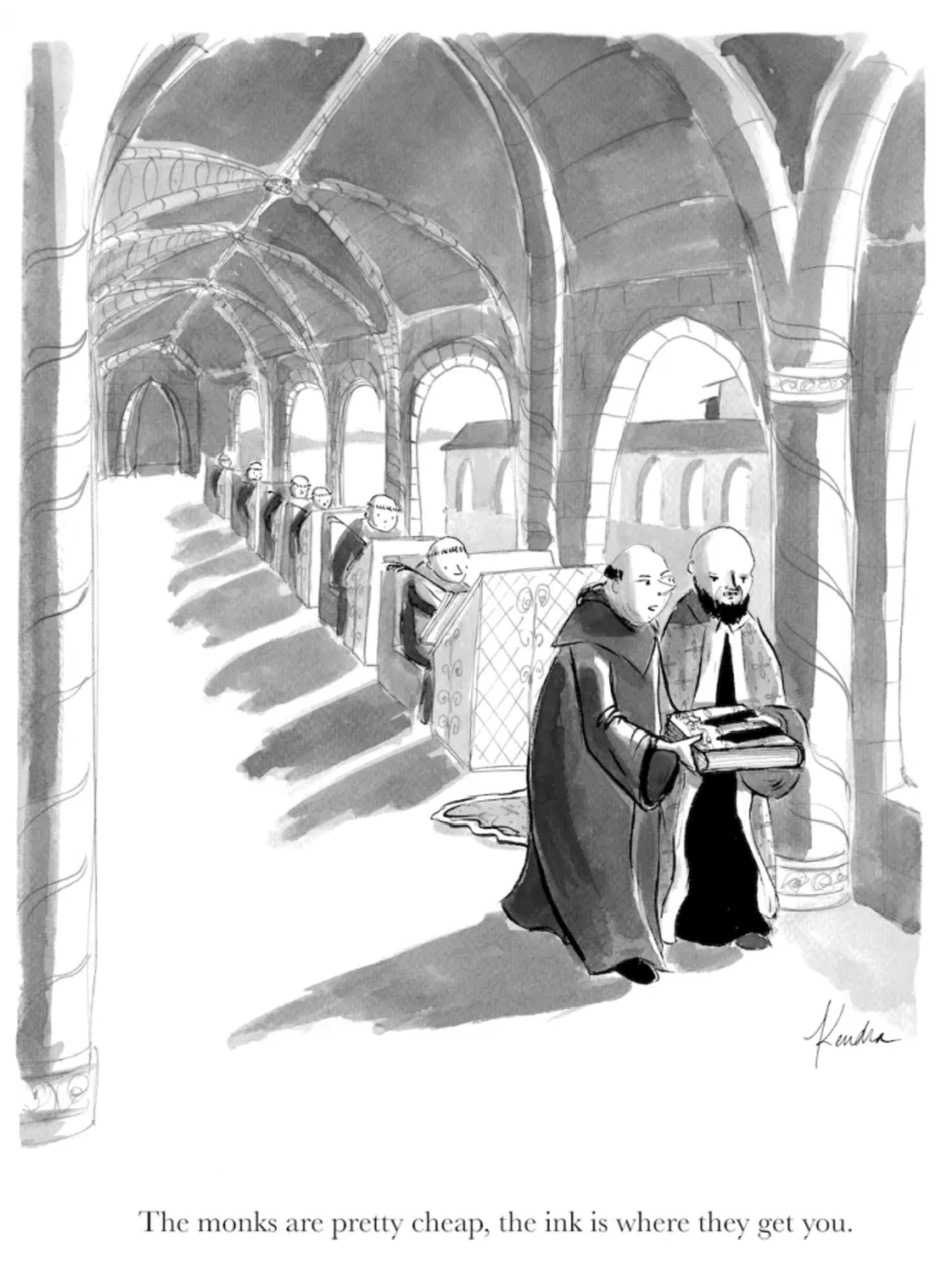














Discussion
Only verified members can comment.